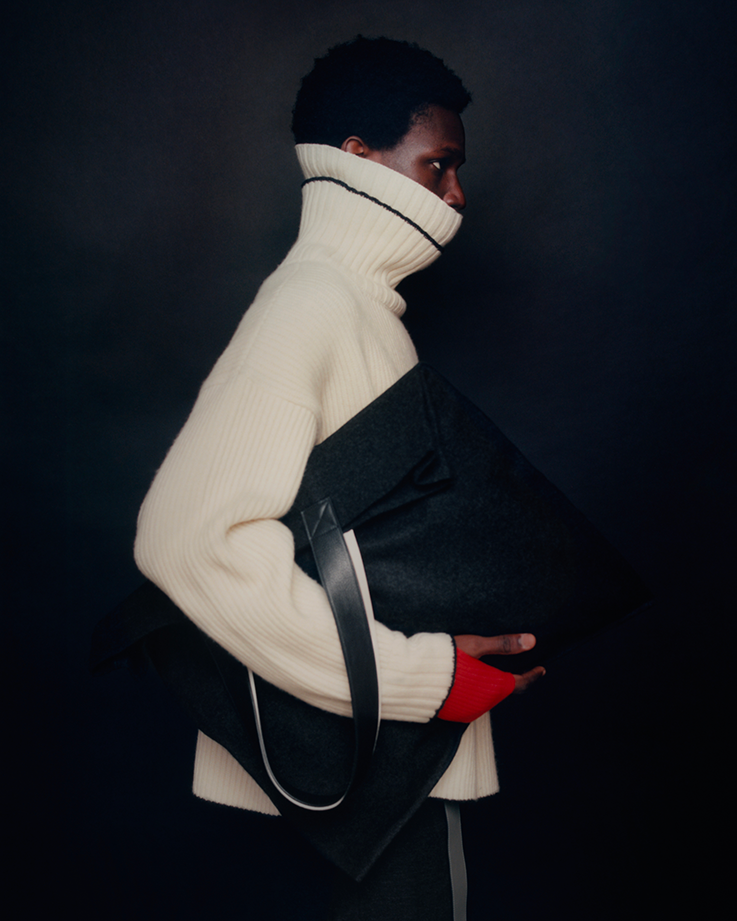The Many Layers of Uniforme

Rémi Bats and Hugues Fauchard of Uniforme have funnelled a pervasive sense of climate anxiety into their Fall-Winter 2022 collection. Based on the visual metaphor of volcanoes, the duo pondered the notion of stratification or the idea of wardrobes as a tool for layering. This, while also considering the damaging impact of fashion on the environment.
This starting point encouraged them to underscore timelessness as a cornerstone of Uniforme. An anti-trend approach sees the collection recall previous silhouettes like ribbed funnel neck sweaters, pleated wide-leg trousers, and wool overshirts, visualised in a palette of dark anthracite grey and black, alongside earthy and mineral tones. Meanwhile, eye-catching sweaters feature boldly hued lava motifs, and tailoring riffs on a volcanologist’s uniform.
With a high-quality, low-impact approach, Uniforme uses deadstock and managed stocks (this time including cashmere, wool flannel, and cotton wool) from premium manufacturers in factories less than three hours from Paris by train. With each season, they strengthen their commitment to serving a consumer in search of conscious fashion while observing the strenuous demands the industry exerts on the environment.
By phone from Paris, Bats and Fauchard explained, “We’ve always said that Uniforme is timeless, but it’s even more true now.”
What would you like us to know about this collection?
The image of volcanoes is how we are constructing the brand season after season. All these layers go together and we always try to connect what we want to say in terms of style with something linked to ecology and sustainability. The metaphor of volcanoes was something to warn people – to remind them that, as soon as you hear an eruption, it’s too late. Basically, the state of fashion today is just like a volcano, it’s way too much. If we don’t listen to what’s going on, eventually it’s going to blow up and it’s going to be a disaster.
Have you always dreamed of becoming designers?
Actually, it’s something that we have in common. We [both] dreamt of doing something with our hands – something more crafty, more artisanal. But growing up, we soon realised that fashion would be a very good medium for this. Every six months, you get the chance to work on something new, to study something new, to have new mediums in terms of craft and inspiration.
What do you think attracts people to fashion?
I think it depends on the time. When we were younger, it was about these crazy fashion shows like Galliano and Margiela. It made you realise, “Wow, this, this can be a job.” Today, I think it’s a way to be political. Fashion is not just here for making beautiful things; it’s a connection to what’s going on in our society. It was another reason why we wanted to pursue fashion at the beginning: we were interested in aesthetics, of course, but we were also interested in global issues and in politics. For our generation, people go into fashion because you have a stage [from which] to speak.
How do you balance fantasy and reality in your work?
We would consider Uniforme to be exactly in-between because it’s inspired by dreams but it’s also very real in terms of the shape of the clothing. When we design a piece, it starts with studying the idea of the collection. For example, last summer we worked on pilot uniforms. Of course, we are not doing cosplay or things like that! Through the fabrics and silhouette, you can kind of dream of being like that and dressing like that on a daily basis. Fabric is very important. It’s one of the reasons why it’s quite tough for us to be in this digital moment as we work a lot on the feeling and the touch of the fabric. It’s quite difficult to translate that into images or video.
Name someone whose own dreams have inspired you.
We’re both big cinema fans; we watch a lot of movies and series and the people who design costumes are an endless source of inspiration for us. Costume goes deeper to the core of the story than fashion when it comes to characters.
To what extent do you think fashion is about proposing/selling dreams?
As kids, as teenagers, back then we would say that fashion was selling dreams because of what we thought it meant; but now that we’re in the system, there are two answers. First, you’re selling things that people don’t really need, but it gives you status in social life. It can also be, in a very good way, used to express what you stand for. When I say that, I’m talking more about the conscious brands that are taking a stand for global warming and making fewer collections. I would say they don’t sell dreams, but they sell commitments; they sell the idea that we can do things differently.
Do you have a dream that remains unfulfilled?
We’d really love to design costumes at some point for movies or theatre. It’s been a dream of ours since we were young.
The interview has been lightly edited for clarity.



